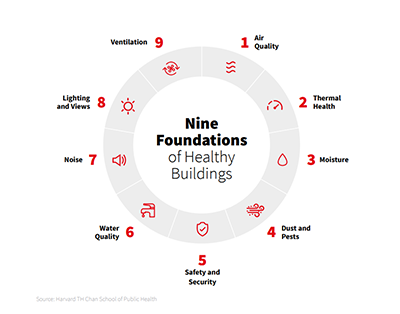
Real Estate Investors Rethink the Value of Green

Chart courtesy of Harvard T.H. Chan School of Public Health via JLL.
Sustainability is moving up the corporate priority list and investors are rethinking value, making the threat of a commercial real estate “brown discount” more real than ever, said JLL, Chicago.
In Return on Sustainability: How the ‘Value of Green’ Conversation is Growing Up, JLL said investors must move beyond the conversation around the “value of green” to instead focus on the long-term return on sustainability.
“The bar is being raised on what it means to be green,” said Guy Grainger, JLL Global Head of Sustainability Services and ESG. “Now that the business case for sustainability is undeniable, the time has come to evolve the valuation conversation.”
The report noted a strong financial incentive for CRE to go green. While investors initially doubted the value of certifications such as LEED in the U.S. and BREEAM in the U.K., new evidence shows green certifications result in a 6 percent rent premium and a 7.6 percent sale price premium. These green premiums are proving so significant JLL said buildings that do not evolve to meet sustainability standards will suffer financially–resulting in what it called a brown discount.
“Green premiums are temporary; brown discounts are forever,” Grainger said.
Last year JLL surveyed CRE executives, investors and corporate occupiers and found:
* 83 percent of occupiers and 78 percent of investors believe climate risk is financial risk.
* 79 percent of occupiers anticipate carbon emissions reduction will be part of their corporate sustainability strategy by 2025.
* 42 percent of occupiers believe that their employees will increasingly demand green and healthy spaces.
“Sustainability and wellness-focused certification systems will need to adapt to meet this new moment,” JLL said. “Up until now, a highly rated green-certified building hasn’t necessarily been a building with the lowest carbon footprint. Certification standards will soon change as LEED, BREEAM and others launch new carbon-centric benchmarks, defining carbon footprint and incorporating additional elements in the calculation. As investors and companies make environmental and social commitments, they will increasingly need to consider their real estate portfolio to meet climate goals.”
The UN Environment Program Finance Initiative also demonstrated how climate risk can affect real estate income, expenses, exit price, liquidity and financing. In Climate Risk and the Impact on Real Estate Values, UNEP-FI said real estate in areas with more frequent or more severe weather events can suffer from reduced rent and occupancy, increased capital and operating costs, higher margins stemming from increased risk, higher debt-service coverage ratios to cover cash flow volatility and fewer potential equity partners. In addition, some capital sources are less willing to lend in higher-risk locations, the report said.
